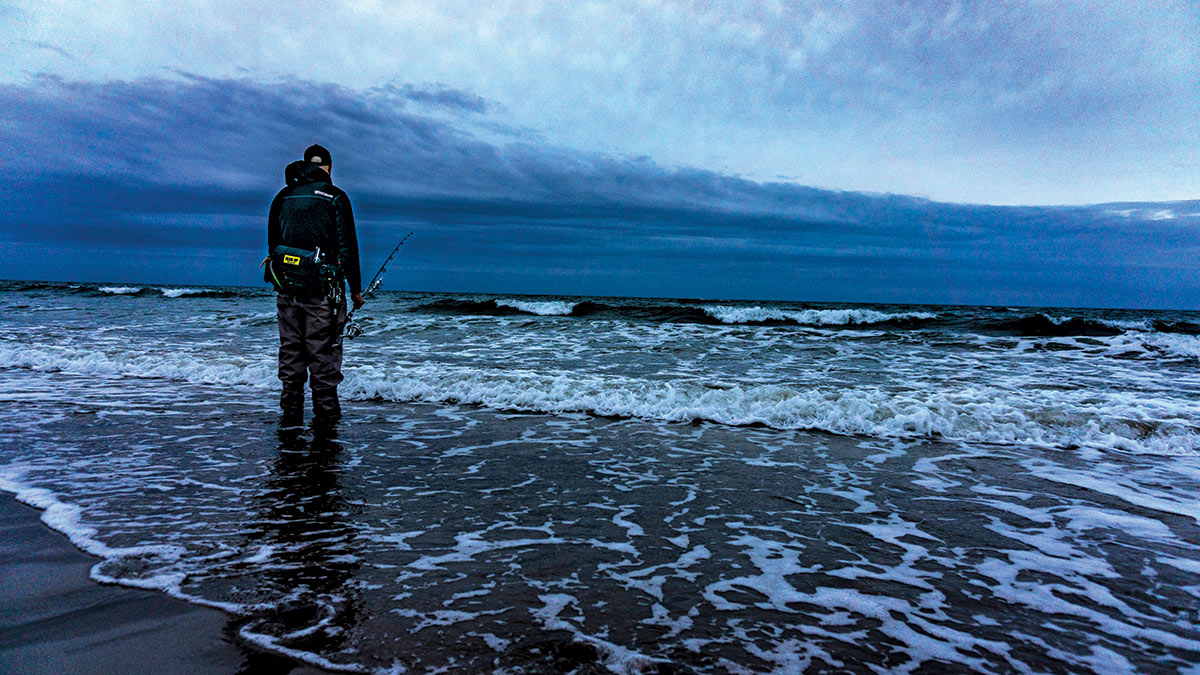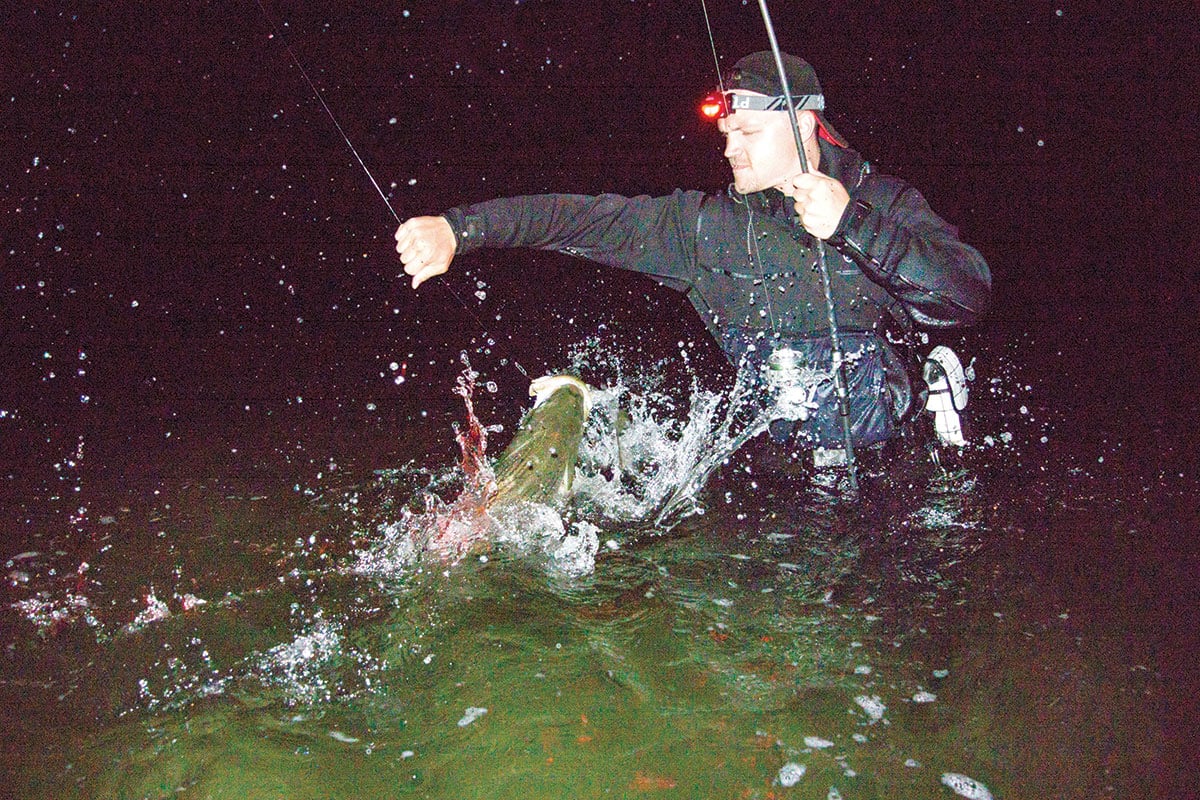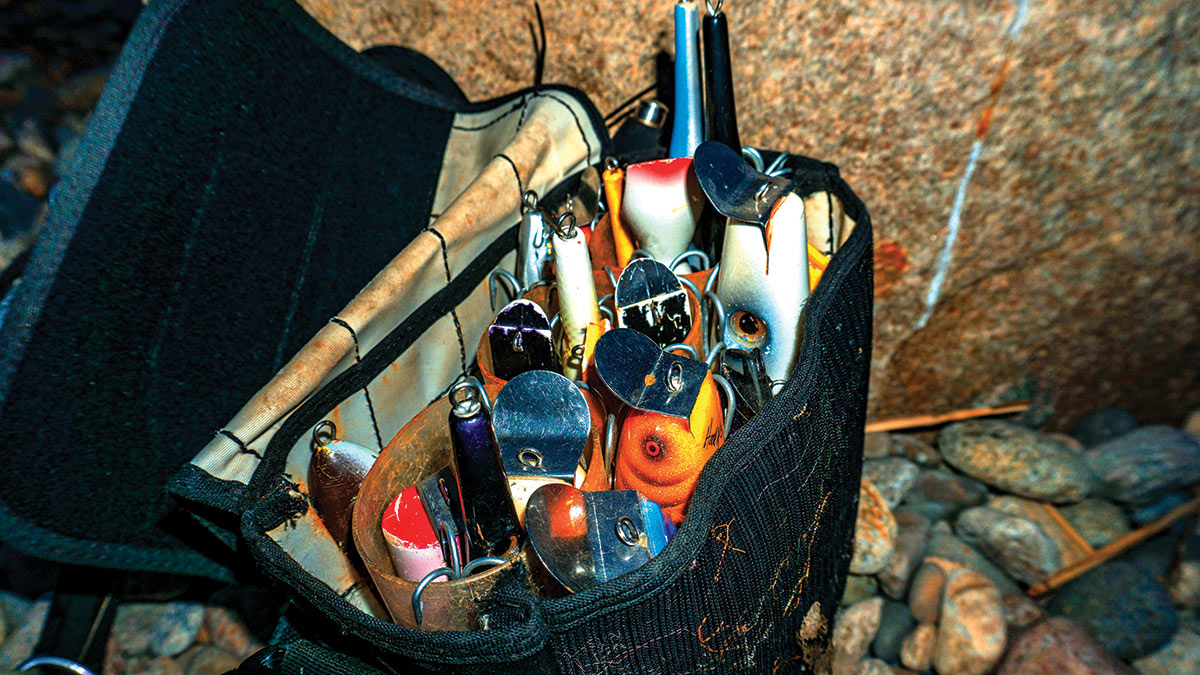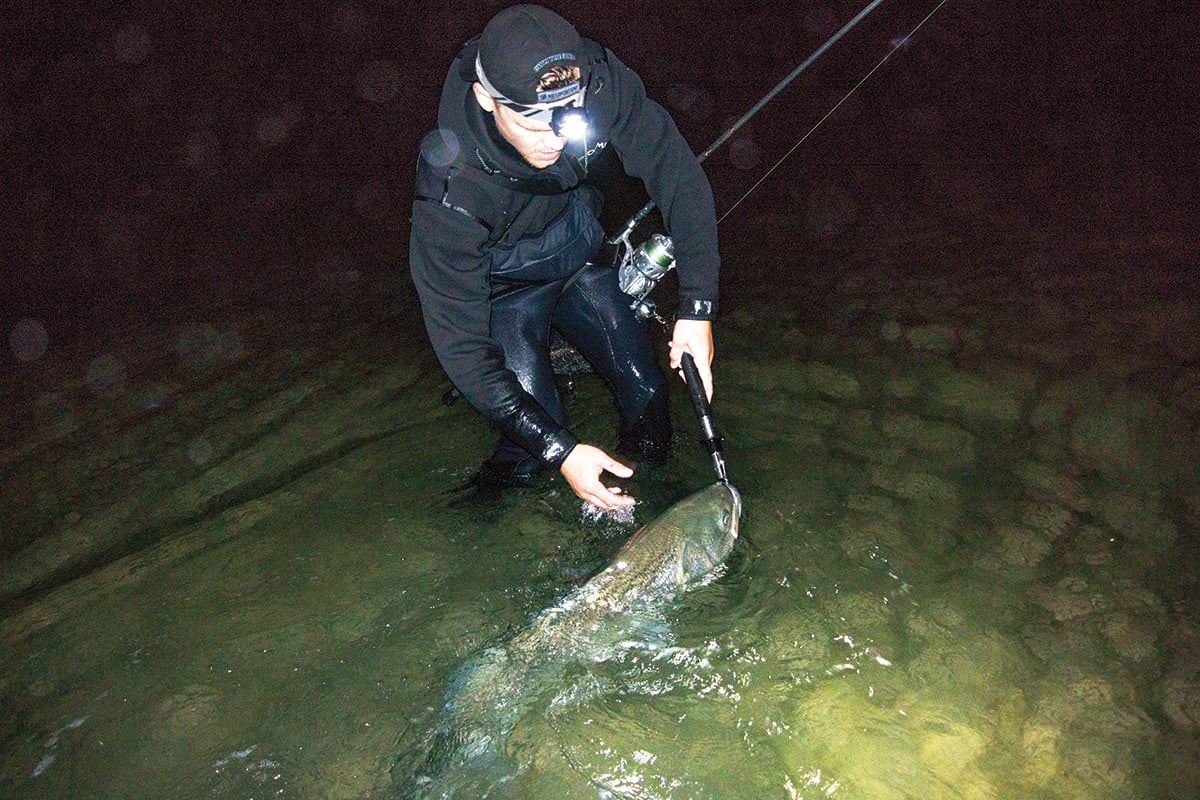
Now is the time to hit the surf for a shot at that new “personal best” striped bass!
It’s May, and that means it’s time to focus on catching a trophy-sized striped bass. May is my favorite month of the year for hunting large fish in the surf, and in the last three out of four seasons my largest fish of the year has come in May or very early June. If you haven’t already, it’s time to buckle down and prepare yourself for hunting big fish. While there have been many things written about the mindset of hunting large fish, I believe I have a few unique takes on the subject to help you in the upcoming season.
Totally Commit
Devoting yourself to pursuing really big fish isn’t easy. It can be fun to catch a lot of moderately-sized fish, especially this time of year. However, if you are committing to getting a personal best this season, you will likely have to forgo the typical schoolie and teen bass bites. If you haven’t done this before, your total catch numbers will probably go down this season. And it can be hard on the ego to give up on hot bites, especially when it’s your buddies that are catching high numbers of smaller fish. However, you must understand prior to setting out that one large fish is substantially harder to catch than several dozen smaller ones. According to recent striped bass stock assessments, there are about 10 times as many fish between 20 and 40 inches, as there are fish over 40 inches. But that only paints part of the picture, because these fish are also more wary and much stronger, and as a result you hook less and lose more of them. And let’s be clear: a 40-inch fish, for me, isn’t even a true trophy-sized cow. I think it’s important to let those numbers sink in and accept that success will be limited, even if you do your absolute best—and that is okay! This is how I mentally prepare myself for the long, empty hours of hunting big fish—I just accept reality.
When it comes to committing, I admit I am at a bit of an advantage because I don’t have the “tug is the drug” addiction that so many others have. I don’t care as much about the action of reeling the fish in, or the fight, as many other anglers do. Sure it’s fun, and a pretty substantial bonus, but for me surf fishing is about the pursuit; a physical and intellectual game of skill, grit and luck. There is no higher stakes game than hunting large fish on plugs (with the exception of fly fishing perhaps). You are lucky if once a tide, or once a week even, you have a handful of minutes that are your window of opportunity at a really big fish. It is not realistic to expect to feel your drag sing every night you head out. You just have to accept this too.

What is more difficult, at least for me, is you also have to come to grips with the fact that you will have to work harder, despite these lower catch rates. That is, the lower number of fish will come at an even greater cost of time and effort. I think that a lot of trophy hunters down play this, or are so sleep-deprived they don’t realize it. There is a massive amount of time invested in catching just a handful of fish, and most of that is spent getting skunked. So I think it’s important to let go of your ego, accept that you have to earn your prize, and that it will not come easy. Further, many other fishermen will not value or understand your hunt for the larger fish, and you have to accept this as well. Many value 200 keeper fish as greater than a single 40-pounder, but I can attest the single 40 is much harder to come by these days. To be clear, there is absolutely no shame in wanting to catch a lot of smaller fish, but that does not go hand in hand with catching trophies. Part of accepting the commitment of catching jumbo fish is also accepting all the compromises and downsides.
Stick to a Good Plan
When it comes to catching my largest fish of the year, I make simple but detailed plans, and I obsess over them. I never just show up and hope the big fish are there. The first part of my preparation is to identify the moon stages for my most critical months (May, June, September and October). It’s not that I won’t hunt large fish during other months of the year; it’s just that these are the most consistent months where I fish, and I want to put the majority of my limited time and effort into them. Next, I identify how the moon stages line up with the night tides at my most reliable big fish spots. I am totally and completely focused on the night. I build a calendar based on these data well in advance of the season, usually sometime in March. I pay special attention to the maximum and minimum tide heights, because this tells me when the moon-phase is peaking, and I specifically focus on those. I then identify nights where the tides and moons line-up closest in the 10pm to 3am time window. I believe this time period (10-3), almost irrespective of time of year, is the best window for hunting trophies for a variety of reasons. However, for the sake of brevity, I believe it is mostly because they are the quietest times when big fish feel safest coming into the shallows.
This results in a block of tides that is usually four to six nights in a row, and as long as nothing drastic happens, I fish all of them regardless if I catch anything the first few nights. When committing to large fish, I think simply sticking to the plan is critical. Yes, I’ve had luck running all over in a single night, and changing it up when things weren’t working out. But for the most part, having a plan and sticking to it is the best road to consistent big-fish success. I never chase reports, and I never fish a spot less than two nights in a row once I’ve set a plan. Also, if the window of opportunity overlaps for multiple spots, I choose based on historical data from my logs. In other words, of the 20 or so spots I fish regularly, I know the handful that are the most consistent year to year, and focus on them first.

In the spring, this is really all I do. I, for the most part, ignore weather and bait, and just focus on these key tides. I have found that tides and moon phase trump just about everything else during the northern migration, with very rare exceptions. In the fall I find weather events—specifically strong low-pressure systems and strong onshore winds—can be equally important, as can bait concentrations. But fundamentally, in the places I fish, I have to have the right tide stage (e.g. high, low, slack, etc.) and water movement direction (i.e. incoming, outgoing), or the weather and bait presence mean very little.
Finally, I have worked hard to make sure that I am 100 percent confident in every plug that goes into my bag. Confidence and commitment to a plug is critical to big fish success. You have to totally believe that what you are throwing is the best possible tool for the job, every cast. It has to be so ingrained in you, you have to be so connected to it, that fishing it feels more like intuition than conscious thought. To this point, I have a select number of plugs picked out prior to even going to the spot; it’s all part of my plan. Of course bigger is better, and I ascribe to this principle almost religiously. A 12-inch or larger lure is nothing to even a moderately-sized striper, and my lure size is only limited by my ability to cast these large hunks of wood and plastic.
Prepare Body and Mind
Quite frankly, when it comes to big fish you have to be prepared to work hard; or suffer depending on how you see it. I do not say this flippantly. I am a firm believer that catching big fish is a lot about putting in the time and effort. I will be candid and say that in the current fishery, I spend upwards of 30 to over 40 hours a week on my feet, for several weeks on end, just to land a couple big fish on plugs during my peak months. It can be taxing on the mind and body, and it takes devotion. However, when you do finally land that really big fish, it is so much sweeter knowing that you really put in your best.
To this point, I like to get in good shape before the season begins. This prepares me for the several (or more) miles I may walk in a night, the two to six hours I will spend standing, and slinging 4- to 7-ounce plugs on a stout 11-foot rod. Strength training and cardiovascular work (power walking, running, biking, etc.) have allowed me to both spend more time fishing, and also help mitigate the effects of many late night tides in a row. Also, working hard in the gym can build mental toughness to stick it out when it gets uncomfortable. There’s nothing worse than missing out on a good bite because you’re too sore or tired to fish one more night in a row!

I have one final tip as well, which may sound a bit bizarre, but I think it is important. I also train my mind for the rigors of big fish hunting. I practice meditation, visualization, and focusing drills that keep me dialed-in on the task at hand. This all started when I lost the largest fish of my life because I was day dreaming about eating pastries, and didn’t get a good hook set. I lost the fish only a few yards from my rock. Since that terrible night, I have committed to being completely mentally focused during trophy tides. As part of this, I don’t particularly care to fish with anyone else on these nights, especially if they are also not committed to trophy hunting. This is because I am completely locked into what I am doing, and want no distractions. When I am in this full-on trophy hunting mode, I work to constantly draw my mind back to the task at hand, exactly as I would do in a mindfulness meditation: how my plug is swimming, what is the water doing, what is going on around me, and am I prepared to strike when the precious hit comes? After all, there is often only one or two really large fish a tide these days, and you do not want to miss them because you were dreaming about donuts!




